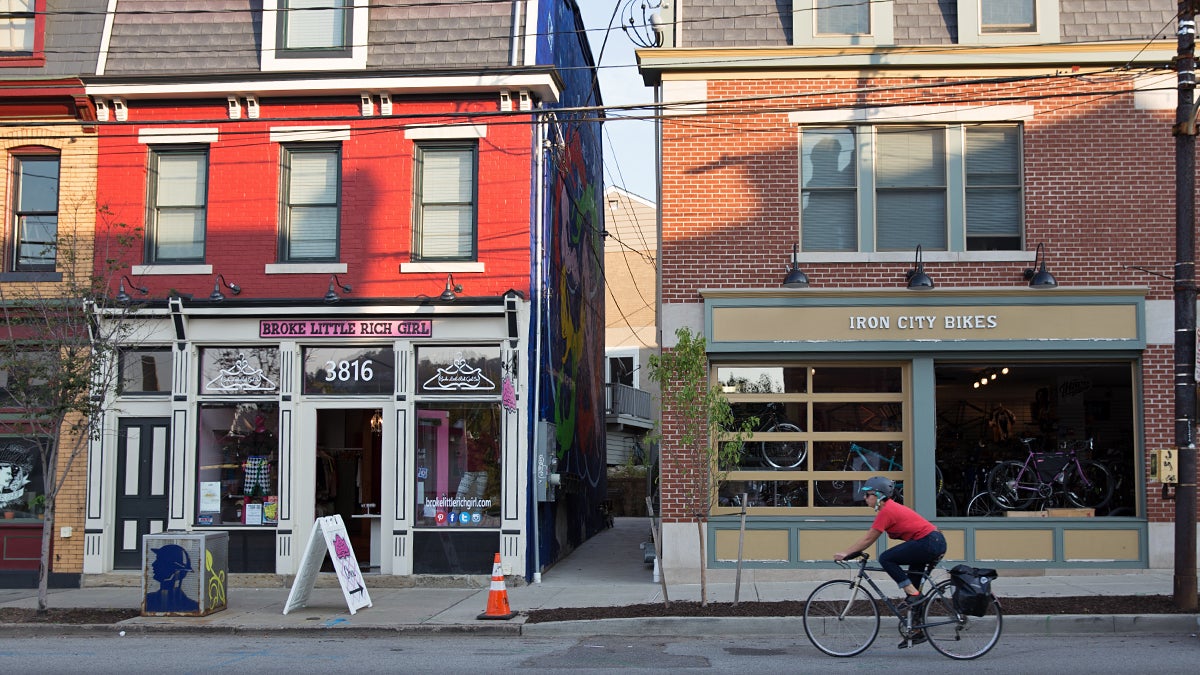Place branding: what’s it mean when identity gets in the way?

A cyclists rides past restaurants and boutique shops on Butler Street in the Lawrenceville neighborhood of Pittsburgh, Pa. (Lindsay Lazarski/WHYY)
Branding cities and, more broadly, places, is a relatively recent trend for communities trying to sell themselves to new people and companies.
In 2011, a group of designers put together a development proposal to make Pittsburgh’s airport more than just a landing pad. The plan included ideas to transform the airport into a larger transport hub that would attract businesses to the vicinity, making for a dense commercial zone. One of the theoretical models in the proposal included something called New Town, literally a new town that would absorb the people coming to take advantage of all the new businesses and jobs the future growth of the airport would spur. “The New Town is a public-private undertaking that creates a distinct new place with a well-defined identity,” the plan read.
But isn’t a well-defined identity – whether positive or negative – something that grows and develops organically, something that takes time and a sense of place? Isn’t a well-defined identity the opposite of a New Town?
Maybe. But maybe it just takes some decent branding.
Branding cities and, more broadly, places, is a relatively recent tentacle of the branding monster that has eaten up, well, everything. A 2006 study by CEOs for Cities, a nonprofit organization that advocates for progress in cities, defined a city brand as “the foundation that helps to make a place desirable as a business location, visitor destination or a place to call home.” And it’s so competitive out there – competition for talented people, for companies – that “how a city stakes out and communicates its distinctive place within [the world] largely decides which cities succeed and which falter in the race for economic prosperity. To this end, places are just like companies: those with a strong brand find it much easier to sell their products and services and attract people and investment.”
Pittsburgh relied on a branding campaign to encourage people to spend more time in its downtown. The city invested in improvements to the downtown and then flaunted them with the Get DownTown campaign. At the same time, Pittsburgh has been blessed with an organic rebranding courtesy of the barrage of superlatives it has garnered in its very real transformation from a steel city to a post-industrial one. Slowly, people’s perception about Pittsburgh is changing. It can still claim its Steel City moniker, but now in a restored, reinvigorated way, hippified. My own neighbor moved to the city from Atlanta on a whim, because she said Pittsburgh sounded cool (i.e. it’s working!).
But how do you do that when the brand doesn’t have time to simmer, like Pittsburgh’s did, or when there isn’t much there to brand in the first place? Like New Town. Or like other smaller communities throughout Pennsylvania that lack a true reputation beyond the town’s borders. Or that have bad reputations, ones justified on the ground? How will the Rust Belt’s many depressed towns and cities brand themselves to each be unique and attractive to the saviors out there shopping around for a new home?
William Hatcher, an Eastern Kentucky University professor, says instead of challenging pricey branding agencies with such assignments, places should look inward and invest appropriately. Responding to a Governing Magazine article about municipal branding, he wrote, “Branding is often when a community is told who they are by well-paid consultants…Identity building is when a community develops strategies to build its assets and advertise them to potential visitors and residents.” He advocates for the latter. For New Town, if it’s ever built, that means a fresh slate upon which to draw its destiny…and identity. The developers will have to order up a plaza, a Main Street, and some sidewalks, and voila! a walkable city, a budding identity. But for older towns with baggage, identity could be a loaded question, with more than just assets at the heart of it. A brand sounds simpler, by comparison.
WHYY is your source for fact-based, in-depth journalism and information. As a nonprofit organization, we rely on financial support from readers like you. Please give today.


